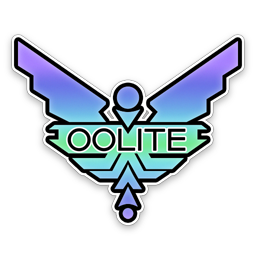Oolite
| Oolite | |
|---|---|

| |
| Developer | Giles Williams |
| Publisher | oolite.org |
| Latest version | 1.76.1 |
| Release date(s) | May 27, 2012 |
| Platform(s) | Mac OS X Linux Microsoft Windows |
Oolite is an Elite-like space sim game, originally written for Mac OS X. Stable ports for *NIX and Windows (XP, 2000 and Vista only) exist, and ports are also available for SGI IRIX and FreeBSD on Intel architectures..
It was written by Giles Williams as response to the withdrawal of Elite - The New Kind from the internet. Although inspired by the work of Christian Pinder, following David Braben and Ian Bell, the work is an independent interpretation and expansion of the original game.
Oolite is designed as a small game that is easy for users to pick up and expand upon. Almost every aspect of the game can be modified using simple, free graphics packages and text-editors.
The game and source-code are offered for free under a Creative Commons License. One of Giles' priorities for development was to separate the game engine from the game materials (graphics, models, AI, text-strings etc.)
Contents
Game style
Oolite follows the original Elite rather than Frontier Elite 2 or Frontier First Encounters. It is set in the classic Elite universe, with the features found in the classic Elite universe (systems and the descriptions of systems generated by an algorithm, rather than text that the author has written). Like classic Elite, there is a single planet per system - although the game allows authors of add-ons to add multiple planets to a star system. Like classic Elite, the flight model is non-Newtonian - meaning the spacecraft handles like an "aeroplane in space". However, this can be thought of as a complex flight computer helping the pilot as the game engine itself allows for real-world physics, for example, during collisions. This can lead to some interesting flight characteristics when the player survives a collision (especially with a Hognose Tugship).
See the Oolite Instruction Manual for more information.
Expandability
The game can be expanded in a number of ways with an OXP (Oolite eXpansion Pack). This takes the form of a directory with the extension 'oxp' that is placed in the AddOns folder. When Oolite is launched, it scans this folder for OXPs, and loads them. An OXP can contain new ships with custom AI and textures as well as new missions. Some notable OXPs have been to replace the space stations in Tech Level 13+ planets with a "2001-style" Torus station, and the Tionisla Orbital Graveyard from the novella, The Dark Wheel.
Portability to other operating systems
The game was originally written to use OpenGL and Cocoa (the Mac OS X toolkit) in Objective C. In April 2005 a porting project was started by David Taylor and Dylan Smith. The port uses OpenGL and the GNUstep Objective-C library. The first stable version was 1.52, released on 24th September 2005. Substantial parts of the graphics output were changed to use SDL (Simple Directmedia Layer), a cross platform game library. This is portable to any Unix-like operating system that supports OpenGL and GNUstep, including back to Mac OS X as a Cocoa/SDL application. The game has been run on the PowerPC, Intel x86, AMD 64 and MIPS processor achitectures.
Getting and installing Oolite
The following articles contain detailed information about where to get and how to run the game. There is also an additional section in these pages on how to build from source for those who are inclined to explore the technicalities of the game.